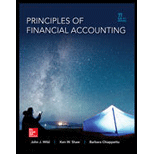
Concept explainers
1.
Ascertain the annual expected net
1.
Explanation of Solution
Cash inflows: The amount of cash received by a company from the operating, investing, and financing activities of the business during a certain period is referred to as
Cash outflows: The amount of cash paid by a company for the operating, investing, and financing activities of the business during a certain period is referred to as
Ascertain the annual expected net cash flows for each project as follows:
Project A:
Therefore, the net cash flow of Project A is $99,900.
Project B:
Therefore, the net cash flow of Project B is $105,900.
Working note 1:
Calculate the
Working note 2:
Calculate the depreciation expense for Project B:
2.
Ascertain the payback period for each project.
2.
Explanation of Solution
Payback period: Payback period is the expected time period which is required to recover the cost of investment. It is one of the capital investment method used by the management to evaluate the proposal of long-term investment (fixed assets) of the business.
Ascertain the payback period for each project as follows:
Project A:
Therefore, the payback period of Project A is 2.40 years.
Project B:
Therefore, the payback period of Project B is 2.27years.
3.
Ascertain the accounting
3.
Explanation of Solution
Accounting rate of return method:
Accounting rate of return is the amount of income which is earned over the life of the investment. It is used to measure the average income as a percent of the average investment of the business, and it is also known as the average rate of return.
Ascertain the accounting rate of return for each project as follows:
Project A:
Therefore, the accounting rate of return of Project A is 33.3%.
Project B:
Therefore, the accounting rate of return of Project B is 21.6%.
4.
Ascertain the
4.
Explanation of Solution
Net present value method:
Net present value method is the method which is used to compare the initial cash outflow of investment with the present value of its cash inflows. In the net present value, the interest rate is desired by the business based on the net income from the investment, and it is also called as the discounted cash flow method.
Ascertain the net present value for each project as follows:
Project A:
| Net present value of investment opportunity | |
| Particulars | $ |
| Present value of annual net cash flow (W.N. 3) | 330,879 |
| Less: Amount to be invested | 240,000 |
| Net present value | 90,879 |
Table (1)
Therefore, the net present value of Project A is $90,879.
Working note 3:
Calculate the present value of annual net cash flow:
Note: The Present value of an ordinary annuity of $1 for 4 years at 8% is 3.3121 (refer table 3 in Appendix B).
Project B:
| Net present value of investment opportunity | |
| Particulars | $ |
| Present value of annual net cash flow (W.N. 4) | 272,915 |
| Less: Amount to be invested | 240,000 |
| Net present value | 32,915 |
Table (2)
Therefore, the net present value of Project B is $32,915.
Working note 4:
Calculate the present value of annual net cash flow:
Note: The Present value of an ordinary annuity of $1 for 3 years at 8% is 2.5771 (refer table 3 in Appendix B).
5.
Identify the project which would be recommended to management and explain it.
5.
Explanation of Solution
Identify the project which would be recommended to management and explain it as follows:
In this case, Project A is better for the investment, and it would be recommended to the management, because Project A ($90,879) has higher net present value than Project B ($32,915). At the same time, Project A (33.3%) has higher accounting rate of return than Project B (21.6%). Hence, Project A is better for the investment.
Want to see more full solutions like this?
Chapter 25 Solutions
Principles of Financial Accounting.
- I am searching for the accurate solution to this financial accounting problem with the right approach.arrow_forwardPlease provide the accurate answer to this financial accounting problem using valid techniques.arrow_forwardPlease provide the correct answer to this financial accounting problem using valid calculations.arrow_forward
- Please fill the empty cell in this problem. It is the only thing I need.arrow_forwardPlease explain the solution to this financial accounting problem with accurate principles.arrow_forwardWhat exactly are intangible assets and how are they defined? How are intangible assets different from plant assets?arrow_forward

 AccountingAccountingISBN:9781337272094Author:WARREN, Carl S., Reeve, James M., Duchac, Jonathan E.Publisher:Cengage Learning,
AccountingAccountingISBN:9781337272094Author:WARREN, Carl S., Reeve, James M., Duchac, Jonathan E.Publisher:Cengage Learning, Accounting Information SystemsAccountingISBN:9781337619202Author:Hall, James A.Publisher:Cengage Learning,
Accounting Information SystemsAccountingISBN:9781337619202Author:Hall, James A.Publisher:Cengage Learning, Horngren's Cost Accounting: A Managerial Emphasis...AccountingISBN:9780134475585Author:Srikant M. Datar, Madhav V. RajanPublisher:PEARSON
Horngren's Cost Accounting: A Managerial Emphasis...AccountingISBN:9780134475585Author:Srikant M. Datar, Madhav V. RajanPublisher:PEARSON Intermediate AccountingAccountingISBN:9781259722660Author:J. David Spiceland, Mark W. Nelson, Wayne M ThomasPublisher:McGraw-Hill Education
Intermediate AccountingAccountingISBN:9781259722660Author:J. David Spiceland, Mark W. Nelson, Wayne M ThomasPublisher:McGraw-Hill Education Financial and Managerial AccountingAccountingISBN:9781259726705Author:John J Wild, Ken W. Shaw, Barbara Chiappetta Fundamental Accounting PrinciplesPublisher:McGraw-Hill Education
Financial and Managerial AccountingAccountingISBN:9781259726705Author:John J Wild, Ken W. Shaw, Barbara Chiappetta Fundamental Accounting PrinciplesPublisher:McGraw-Hill Education





